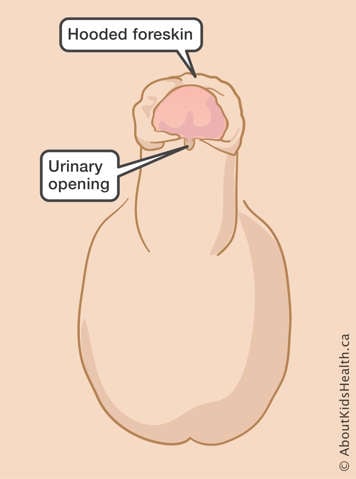What is hypospadias?
Hypospadias is a condition where the urinary opening of the penis is not located at the tip of the penis.
Distal hypospadias
Your child has distal hypospadias if the urinary opening is located on or near the head of the penis. Your child will usually be able to urinate (pee) with a single urinary stream. Even with a normal, straight urine stream, your child may need to aim a bit when they pee into the toilet.

As shown in the illustration, your child’s urinary opening will be slightly lower on or near the head of the penis. Their foreskin will also appear hooded, and the head of the penis may have a mild forward tilt.
Hypospadias management
When managing your child’s hypospadias, two main functional factors are considered:
- Your child’s ability to urinate (pee) with a single urinary stream that they can easily manage.
- Their ability to have natural penetrative sexual function in the future.
These two functions are the main goals in the management of hypospadias and will be considered when determining whether your child requires surgery.
Since these two functions are usually normal in distal hypospadias, there is usually no medical reason for any surgery. If surgery is being considered for aesthetic reasons, this decision should be made with your child’s input. Circumcision (if desired) should also be delayed until your child has been seen by a paediatric urologist.
Role of hypospadias surgery
The role of hypospadias surgery is primarily to address the two functional factors of hypospadias management. It involves operations to correct significant curvature and move the urinary opening closer to the tip of the penis to restore normal urination and sexual function. For distal hypospadias, there is no added functional or performance reasons for surgery. Any surgery for distal hypospadias would only be to alter how the penis looks.
Possible benefits of having surgery for distal hypospadias as a child
- The majority of adult men who have had hypospadias surgery as a child have no regrets with receiving the operation.
- Surgery can address mild symptoms of hypospadias, like abnormal sensations at the opening of the penis, that can be experienced in adulthood.
Possible problems with having surgery for distal hypospadias
- Possible risk of bleeding and infection, as with all surgeries
- Risk of over-healing or scarring that makes the urinary opening too tight
- A cosmetic surgery has the risk of creating new functionality problems that were not previously an issue, including:
- new pain, urinary tract infection, or difficulty emptying the bladder
- complications with healing at the new opening
- a side leak in the urethra (a fistula)
- Your child may need additional surgeries if a new functional problem develops due to the first surgery
- A problem was introduced where there was none before
- Could become a re-occurring issue
- Your child may be unhappy with the results as they become older
What are the benefits of not having surgery in infancy or early childhood?
- Children can participate in the hypospadias conversation. This way, your child can help make an informed decision around their hypospadias and better understand why surgery might be the right choice for them.
- Hypospadias surgery can be performed at any age, and adults with hypospadias can still request to have surgery if they desire. Hypospadias surgery for aesthetic reasons is covered by OHIP for Ontario patients at any age.
If your child is already beyond the early infant and childhood years, it would be reasonable to wait a little longer until your child is old enough to describe their feelings about the look and function of their penis. They can then participate in making, or even make, their own decision about their hypospadias.
Active Surveillance
As long as your child’s penis is functioning normally, no surgery is necessary. At Sick Kids, your child will be actively and regularly monitored by the hypospadias clinic (Active Surveillance). The goal is to help your child understand their developing feelings about the look and function of their penis. It is important to support their feelings concerning their distal hypospadias—as well as help them understand their options as they get older—if they show interest in having surgery to change the appearance of their penis. This does not necessarily mean waiting for your child to become old enough to make the decision completely for themself, but it allows for your child to participate in shared decision-making about the appearance of their own genitals.
How Active Surveillance works
In the absence of functional problems, it is important to follow your child to see how the penis is developing and understand their attitudes towards their penis. Your child’s health-care team will schedule a virtual check-in every 6 – 24 months, until your child approaches puberty. You and your child will receive a very short list of questions to answer about how your child is doing. You or your child will also take and send progress photos of the hypospadias through a secure eHealth service (MyChart), which will be automatically and confidentially entered in their medical record.
Active Surveillance for hypospadias will follow your child through 18 years of age and beyond. At any point, if your child develops an interest in aesthetic hypospadias surgery, the hypospadias team will be able to guide and support your child’s decision so that they are comfortable and confident in any choice they may make. Hypospadias surgery for aesthetic reasons is covered by OHIP for Ontario patients at any age.
At SickKids
If you have any questions about your child’s hypospadias, please use MyChart messaging to contact the urology clinic nurses. If you do not receive a response within 48 hours, please use the following contact information:
Urology clinic: 416-813-6661
E-mail: urology.nurses@sickkids.ca